
Andrew Larsen
This location can be placed anywhere in Prax or the Wastes, as the narrator needs. It is best located in a more remote and mountainous area, such as the Eiritha Hills, the eastern side of the Condor Crags, or the Bleak Hills. It is well-known to the shamans of Waha and other Praxians may have heard of it, but few non-Praxians know of it (unless the narrator chooses to place it near an Oasis or other settlement).
Waha and the Bad Spirits 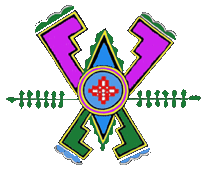
During the Great Darkness, Waha confronted many bad spirits who plagued the Wahano and Eirithana. Although he fought them many times, and always triumphed, they continued to plague Prax. Finally he went and dug a deep cave in the hills, so deep that no light or wind could reach to the bottom of it. He made certain that there was only one way into or out of the cave. Then he went and tracked down the evil spirits, one by one. Some he wrestled and tied with ropes and threw into the cave. Others he chased and as they fled from him, he drove them into the cave. Others he tricked into entering the cave. Then he ordered Oakfed, the Wildfire, to stand at the mouth of the cave and burn those spirits who tried to leave until they died or fled back into the cave. He drew the mouth of the cave low to the ground, so that the foolish would not be tempted to enter. Occasionally, when the Wahano are bad, and forget the way of Waha, he allows some of the bad spirits out for a time, so that they can plague the Wahano and remind them of why they must follow Waha’s yassa.
The Cave Today
The cave is located at the base of a low range of mountains. It is home to a small stand of saxual trees, which provide the only source of water in the immediate area. The cave itself has a very low entrance, barely three feet high, which resembles a scowling mouth; most who enter the cave must do so on their hands and knees, although Impala and Bolo Lizard riders merely have to crouch down.
Inside, the cave has a fairly high ceiling. The walls of the cave are painted with many scenes depicting Praxian myths, including the Survival Contest, Waha’s struggles with Oakfed and the Dark Eater, Oakfed’s fight with Zola Fel, and the digging of the Good Canal. The front portion of the cave is a shrine to Waha and Oakfed, and also the residence of the shaman who tends the shrine.
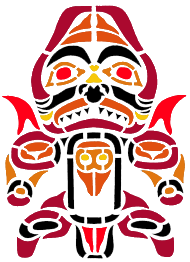 Further back the cave narrows and turns downward into the earth. At the point where it narrows is a fire pit in which a large fire burns but produces no smoke. This is the Holy Fire of Oakfed, and it is sacred to that Great Spirit; it is, in fact, a piece of Oakfed. It must be kept constantly alight, because it is the thing that keeps all the bad spirits trapped deeper in the cave. The fire itself will harm or destroy any spirits forced into contact with it, depending on how powerful the spirit is. Any spirits brought into the cave become more uncomfortable the closer they get to the fire. (If you are playing Runequest, bound spirits complain and familiars will refuse to approach it. If you playing Heroquest, animist characters must make a Tradition score roll against a High Difficulty to persuade the spirits they have charms from to stay with them; failure causes the spirits to depart as if they had been released, so that they must be rebound.)
Further back the cave narrows and turns downward into the earth. At the point where it narrows is a fire pit in which a large fire burns but produces no smoke. This is the Holy Fire of Oakfed, and it is sacred to that Great Spirit; it is, in fact, a piece of Oakfed. It must be kept constantly alight, because it is the thing that keeps all the bad spirits trapped deeper in the cave. The fire itself will harm or destroy any spirits forced into contact with it, depending on how powerful the spirit is. Any spirits brought into the cave become more uncomfortable the closer they get to the fire. (If you are playing Runequest, bound spirits complain and familiars will refuse to approach it. If you playing Heroquest, animist characters must make a Tradition score roll against a High Difficulty to persuade the spirits they have charms from to stay with them; failure causes the spirits to depart as if they had been released, so that they must be rebound.)
The shaman who controls the Cave of Waha may, if he wishes, allow a character to contact Oakfed through the Holy Fire. This is an unusual honor; shamans of Waha or Oakfed are likely to be permitted to do so, especially if they can offer a clear need to do so; other Praxian shamans will probably have to work to persuade the guardian of the shrine. Non-Praxian animists are unlikely to be able to convince the guardian without remarkable circumstances, since the Oho-wahano do not respect Waha’s yassa.
If Oakfed is contacted and appeased here, he will allow a character to take away either some of the ash from the fire pit or one of the sticks. Characters with Water Rune association will never receive either treasure. Both have magical uses.
The Sacred Ash harms impure creatures, including things with Chaotic Features and corporal undead (including zombies, skeletons, and vampires); other creatures may be impure depending on the Narrator’s decision. In Runequest terms, a dose of the ash will inflict 3d6 damage to an impure creature; if combined with rune magic that controls the wind, it will inflict 1d6 damage to a large group of target creatures. In Heroquest terms, it will provide a temporary ability of Burn Impure creature at 17; it is unlikely that characters will get enough Sacred Ash to make it a permanent ability.
A Sacred Firestick is a partly charred piece of saxual wood. It will ignite upon command and will burn until commanded to extinguish; despite burning, it is never consumed. A Sacred Firestick holds some of Oakfed’s power against spirits. In Runequest, it has a POW of 15 and must be attuned; it grants the holder a bonus of +20% when in Spirit Combat. In Heroquest, it grants the character a Burn Spirit ability at 17, and may be acquired permanently by spending 1 Hero Point. As long as the character possesses a Sacred Firestick, he or she gains the Taboo Never Bathe; should the taboo be violated, the Sacred Firestick immediately bursts into flame and is consumed.
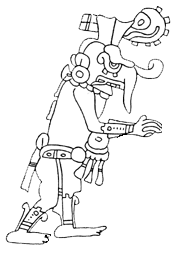 The cave continues down into earth, but it is dangerous for characters to go beyond the Holy Fire unless they are equipped with a torch lit from the Holy Fire, because they will probably be swarmed by bad spirits. In Runequest, characters will find themselves repeatedly in Spirit Combat with powerful spirits. In Heroquest, they will need to make a roll against Very High or Nearly Impossible Difficulties. If equipped with a Holy Fire torch, spirits will hover around the edge of the light, but will not approach; eventually though, such a torch will begin to sputter and go out as it is consumed.
The cave continues down into earth, but it is dangerous for characters to go beyond the Holy Fire unless they are equipped with a torch lit from the Holy Fire, because they will probably be swarmed by bad spirits. In Runequest, characters will find themselves repeatedly in Spirit Combat with powerful spirits. In Heroquest, they will need to make a roll against Very High or Nearly Impossible Difficulties. If equipped with a Holy Fire torch, spirits will hover around the edge of the light, but will not approach; eventually though, such a torch will begin to sputter and go out as it is consumed.
Despite the risks, there are reasons to descend into the Cave of Waha. It is a Spirit Place, and contacting spirits here is easier than elsewhere. Entering the Spirit Plane is also easier here. It is also a place to contact a variety of knowledgeable but dangerous spirits that are too powerful to summon elsewhere.
The Guardian of the Cave
The Cave of Waha has been continuously tended by a shaman of Waha or Oakfed since the Darkness. Some guardians have simply committed themselves to this duty, while others have been given a Taboo by Waha or Oakfed requiring them to tend the shrine. The guardian of the shrine (or the senior guardian, if there is more than one) is considered to outrank all other Waha shamans except the High Khan of a Nation or the Greatest Khan at the Paps, but his authority only extends within the Cave and its immediate vicinity. When the guardian dies, he is cremated in the Holy Fire.The current shaman is Chaka Old-as-Dust, a Bolo Lizard Rider. As his name suggests, he is extremely old, nearly 200, and has lived at the Cave since he became a khan. He is tiny and stooped with age; he is barely three feet tall. He rarely wears clothes anymore, since he is generally alone. His eyes are sharp, but he tends to talk to himself when not actively conversing with someone, and sometimes forgets that he is talking to living beings and drifts into conversations with spirits. Despite this, he is not senile, but very sharp, and deeply knowledgeable about spirits; about some matters involving spirits, he is more knowledgeable than any living khan of Waha. His Bolo Lizard has been dead for a very long time now, and Old-as-Dust has not used a weapon, except for ritual purposes, in decades. Should players attack him, he is easy to defeat physically, but very dangerous magically. In Heroquest terms, he has Spirit, Death, and Mastery runes; if confronted physically, he presents a Low Difficulty, but he commands a wide range of spirits and if he can respond magically, he presents a Very High Difficulty.
The Bad Spirits of the Cave
There are a wide variety of bad spirits trapped in the Cave of Waha. Almost any dangerous spirit that the Narrator needs can be found here, although few of them are Chaotic. All are hostile spirits, although some of them can be negotiated with, while others are mindlessly malevolent. Here are a few options. Runequest narrators will have to provide statistics for them. Some of these can only be found at the Cave, while others can be encountered elsewhere in Prax and the Wastes.
The Ungtai 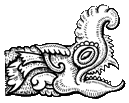
These are spirits of Hunger, who came to Prax following the Dark Eater. They appear as silhouettes with enormous empty mouths. The Ungtai are mindless, driven simply by an insatiable hunger. They attack living targets and seek to possess them; if they succeed, the victim immediately begins seeking food to eat. The victim will do nothing but eat, and will do whatever is necessary to get food; herbivorous creatures will eat whatever plant matter they can find, while meat-eaters will attack the closest living creature and seek to eat it. Those possessed have remarkable strength, and if unable to eat will struggle with almost berserk frenzy. The Ungtai are by their nature a violation of the yassa; they eat things that are not to be eaten, and they do not butcher the animals they consume. Praxians who are possessed by an Ungtai must be purified after they are exorcized, unless they have been prevented from breaking the yassa’s food laws.
Ungtai are associated with the Hunger Rune. 
Chagga, the Filthy Mother
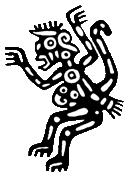 Chagga was one of the grand-daughters of Eiritha; each Nation claims she belongs to another Nation (thus the Sables claim she was a High Llama, while the High Llamas say she was Bison). When Eiritha commanded her children to be fertile and give birth, Chagga began to mate with bulls of all kinds, and with humans as well. Eiritha was horrified and told her that what she was doing was wrong, but Chagga said that she wished to be like her grandmother and give birth to many nations. She produced many children, some of whom Waha succeeded in trapping in his cave.
Chagga was one of the grand-daughters of Eiritha; each Nation claims she belongs to another Nation (thus the Sables claim she was a High Llama, while the High Llamas say she was Bison). When Eiritha commanded her children to be fertile and give birth, Chagga began to mate with bulls of all kinds, and with humans as well. Eiritha was horrified and told her that what she was doing was wrong, but Chagga said that she wished to be like her grandmother and give birth to many nations. She produced many children, some of whom Waha succeeded in trapping in his cave.
Chaggas appear as human women and cows of different types who are grotesquely pregnant; their bellies drag on the ground and their breasts or udders hang low as well. They only attack females of species associated with the Man or Beast rune. Often, they attack as their victims sleep. Once possessed, the victim becomes pregnant (regardless of age), and the pregnancy progresses rapidly, coming to term in less than a week. They give birth and then find themselves pregnant again the next day. Unless exorcised, the victim will gradually get weaker and weaker and finally die of exhaustion.
The possessed mother gives birth to something unusual, but exactly what varies enormously. Most commonly it is a calf or baby of a different species from the mother, so that an impala will birth a gern, a bison may produce an agimori, and a human may drop a sable. Sometimes the victim will produce twins, triplets, or more, not always of the same species. Rarely, a human gives birth to a full-grown human, with the knowledge and skills of a baby. Praxians consider such offspring to be unclean, and usually kill them at birth, but non-Praxians often mistake them for spirits made flesh. If they survive to maturity, they are always malevolent. Cows that have been possessed by a chagga are butchered and their meat left to rot; exorcized women are considered unclean and must undergo an Eirithan heroquest before they are permitted to lie with a man again.
Chaggas are associated with the Life Rune.
Waroolo
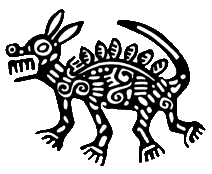 Waroolo is the spirit of stampede. It plagues herd beasts and humans associated with beasts. Waha wrestled it into the Cave, but regularly releases it to trouble the Wahano and force them to prove their strength. It most commonly attacks herd beasts, but can affect mounts just as easily. It does not possess them, but simply moves among them, filling them with fear and driving them to flight. Waroolo can also frighten sentient beings with a Beast Rune connection. This includes Awakened creatures, Morokanth, and Eiritha and Foundchild worshippers, among others, but it is less powerful against them.
Waroolo is the spirit of stampede. It plagues herd beasts and humans associated with beasts. Waha wrestled it into the Cave, but regularly releases it to trouble the Wahano and force them to prove their strength. It most commonly attacks herd beasts, but can affect mounts just as easily. It does not possess them, but simply moves among them, filling them with fear and driving them to flight. Waroolo can also frighten sentient beings with a Beast Rune connection. This includes Awakened creatures, Morokanth, and Eiritha and Foundchild worshippers, among others, but it is less powerful against them.
In Runequest terms, Waroolo can automatically inspire fear and flight in Fixed-INT creatures. Against sentient beings with a Beast Rune connection, it attacks with a POW of 15; those it overcomes must flee in fear. Each round, the target may roll to overcome a POW of 15, and if successful, the panic subsides. In Heroquest terms, regular beasts have a Nearly Impossible Difficulty to resist it, while sentient beings with a Beast Rune connection have a High Difficulty. Those who do not resist must flee for a duration determined by the degree of failure.
Only Waha shamans know the proper technique for sending Waroolo back to the Cave. If any other shaman defeats it in Spirit Combat, Waroolo will flee, but will return within a day or two to continue plaguing the clan. If a Waha shaman defeats it, however, it can be forced into a leather bag and buried in the ground. This will force it to return to captivity in the Cave.
Waroolo is associated with the Disorder Rune.
The Bad Ancestors
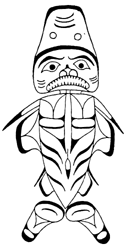 Back in the Great Darkness, when Waha commanded the Survival Contest, some humans refused to play, and they rejected Waha’s yassa, doing things he had forbidden. Waha tricked them into entering the Cave, but they often find ways to escape. The Bad Ancestors do not attack characters, but rather seek to seduce them with promises of magic they can find nowhere else. But the magics they offer always require the characters to violate the yassa or the strictures of their Tradition. Thus they offer healing magics to the followers of Waha, and death magics to Eirithans. Or the charms they offer come with Taboos that require the character to kill an animal without using the Peaceful Cut. If the character accepts the magic and then is plagued by a Spirit of Reprisal, the Bad Ancestor will help defend the character, thus increasing his alienation from the Praxian Traditions.
Back in the Great Darkness, when Waha commanded the Survival Contest, some humans refused to play, and they rejected Waha’s yassa, doing things he had forbidden. Waha tricked them into entering the Cave, but they often find ways to escape. The Bad Ancestors do not attack characters, but rather seek to seduce them with promises of magic they can find nowhere else. But the magics they offer always require the characters to violate the yassa or the strictures of their Tradition. Thus they offer healing magics to the followers of Waha, and death magics to Eirithans. Or the charms they offer come with Taboos that require the character to kill an animal without using the Peaceful Cut. If the character accepts the magic and then is plagued by a Spirit of Reprisal, the Bad Ancestor will help defend the character, thus increasing his alienation from the Praxian Traditions.
The Bad Ancestors have a variety of Runes, depending on their nature.





